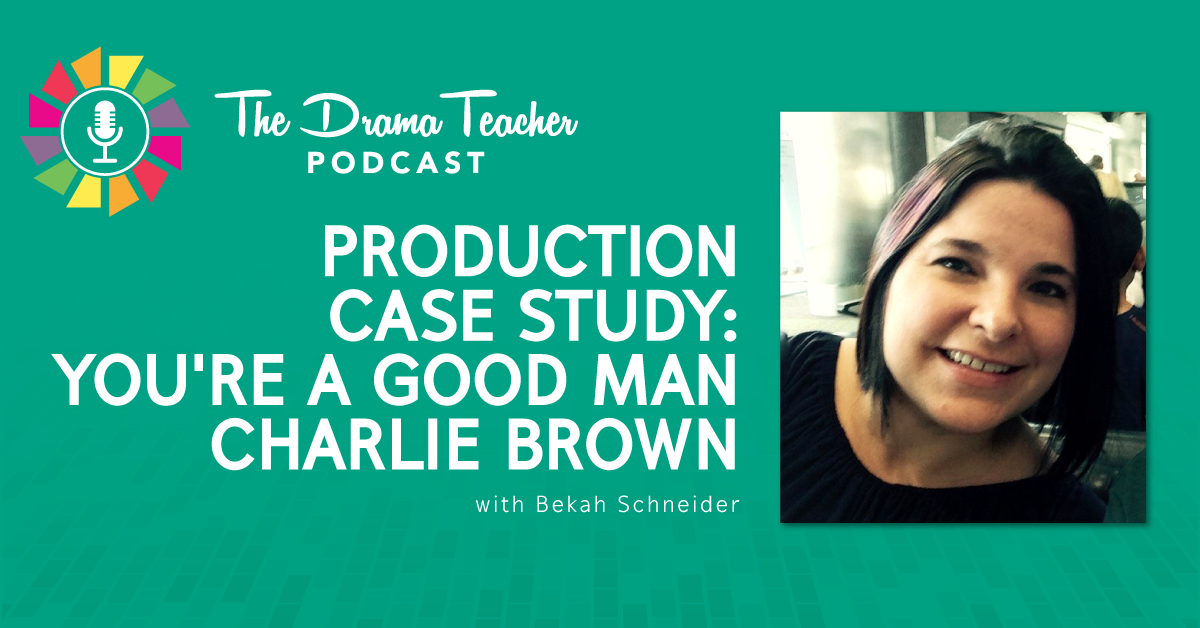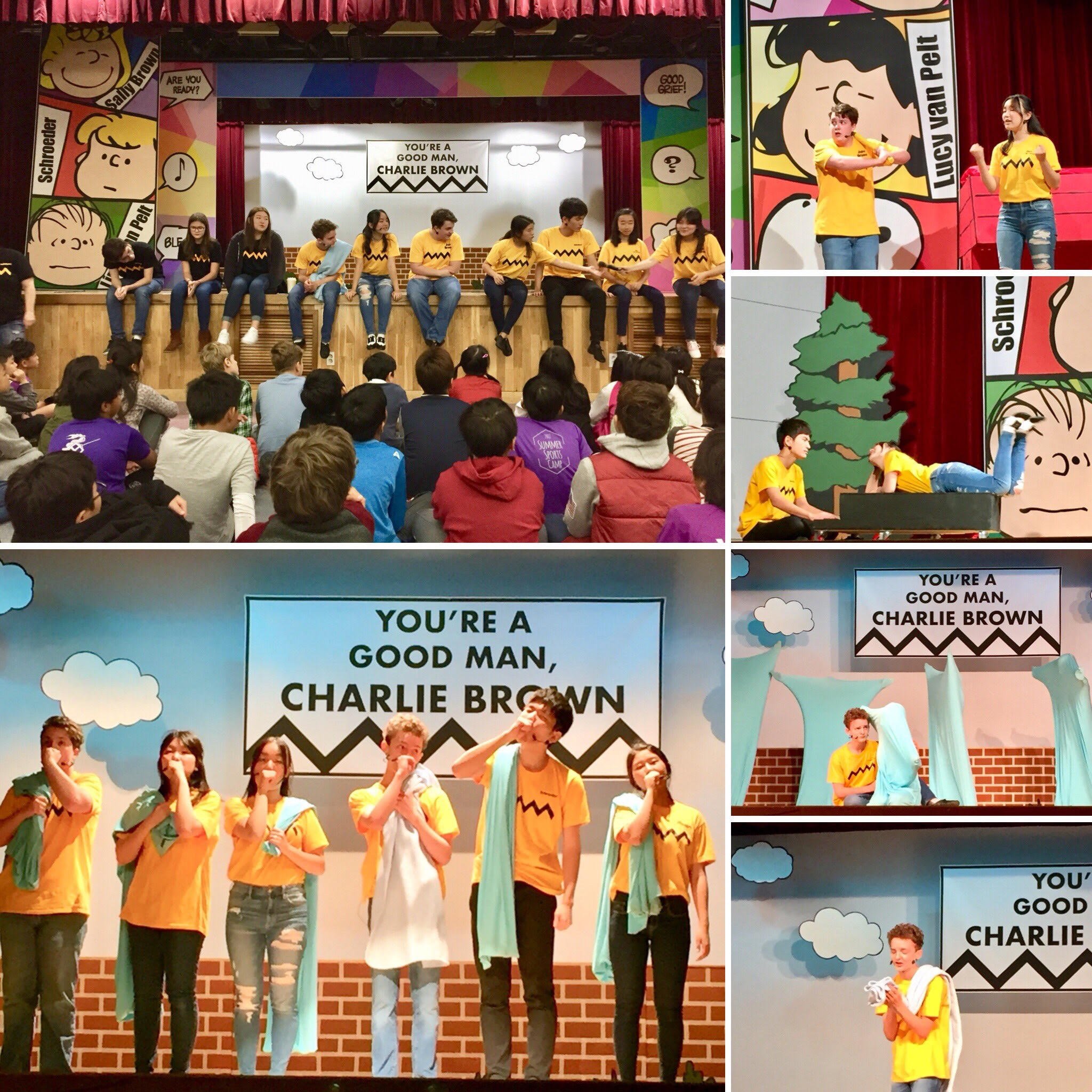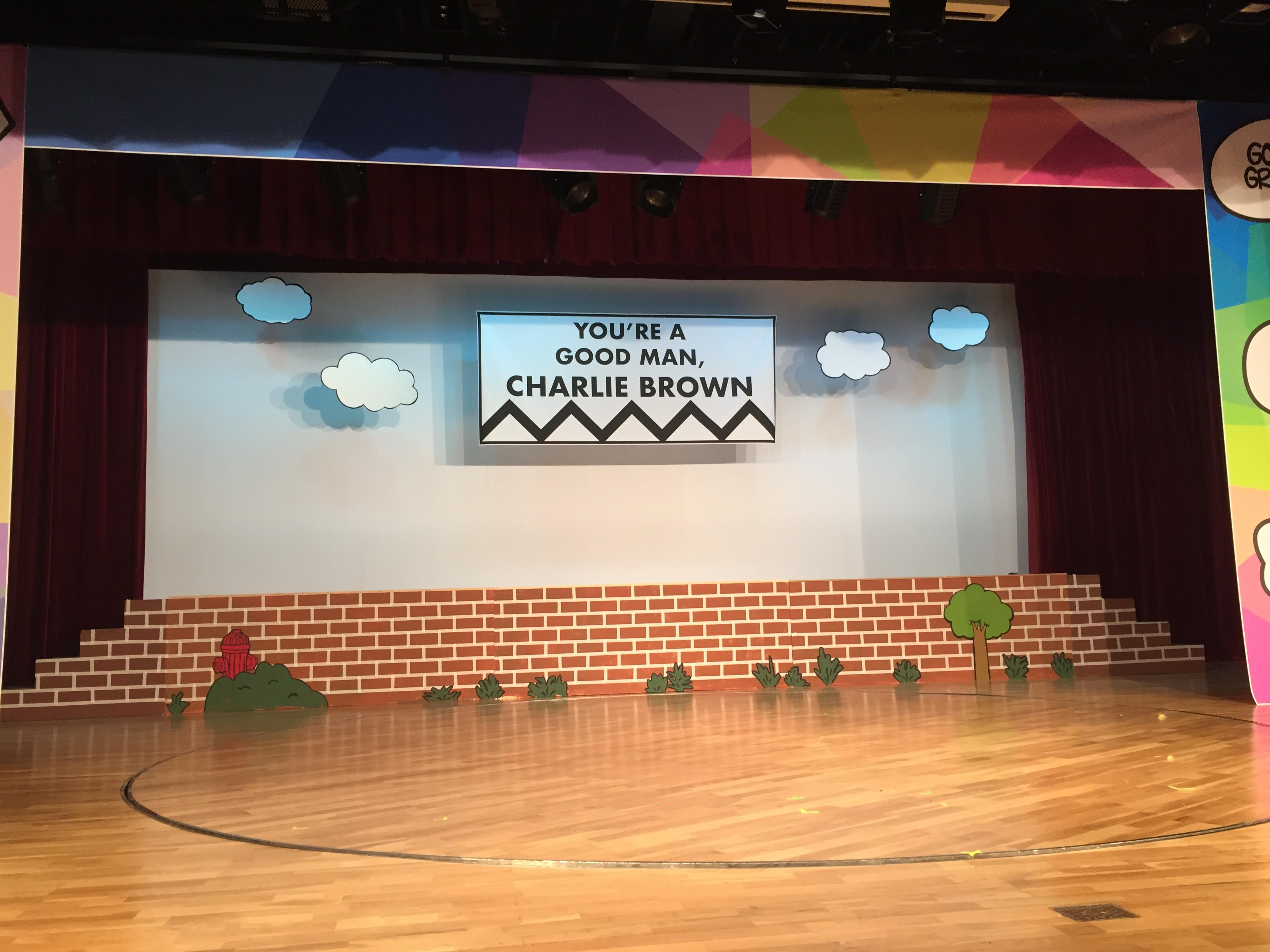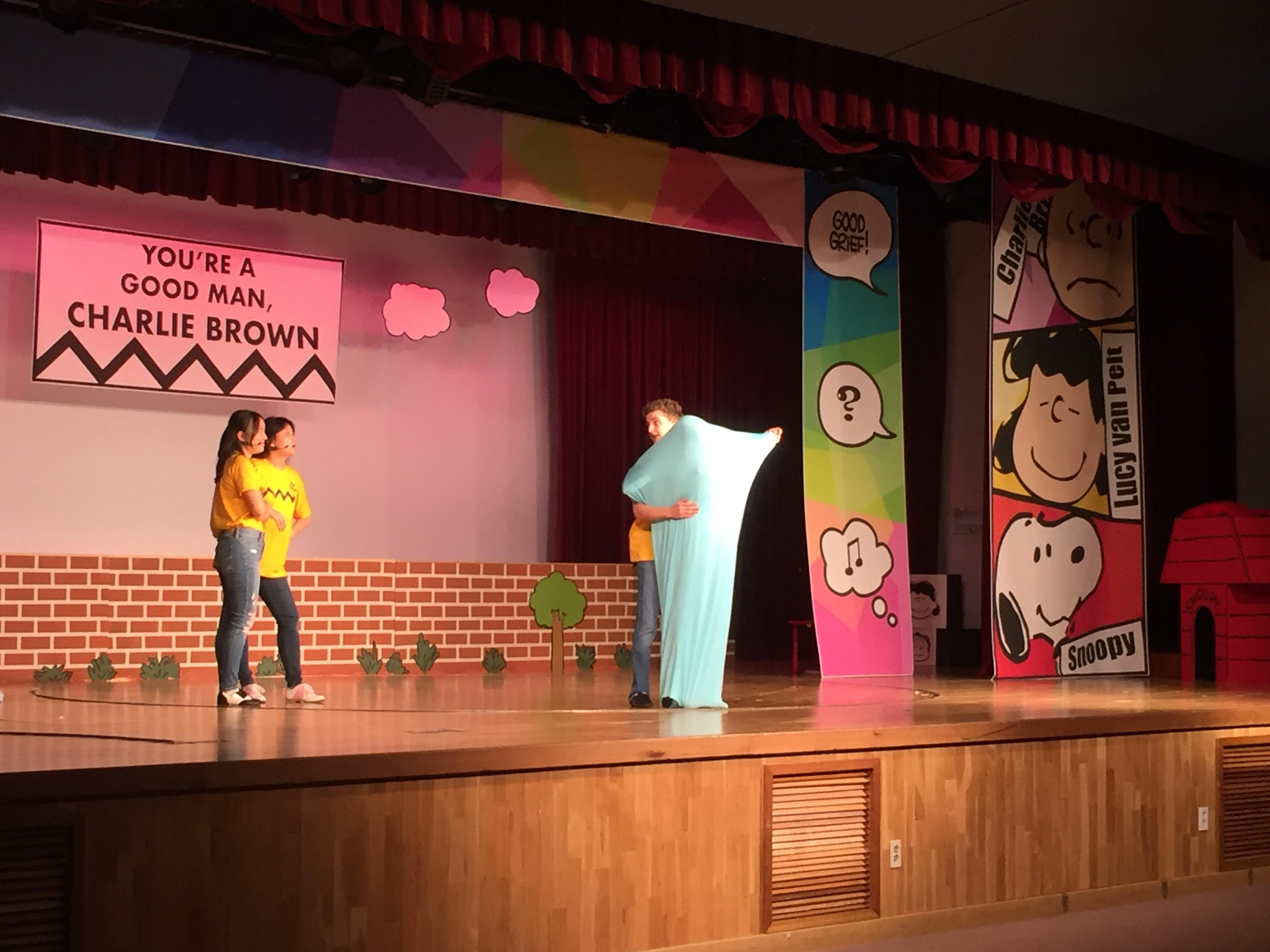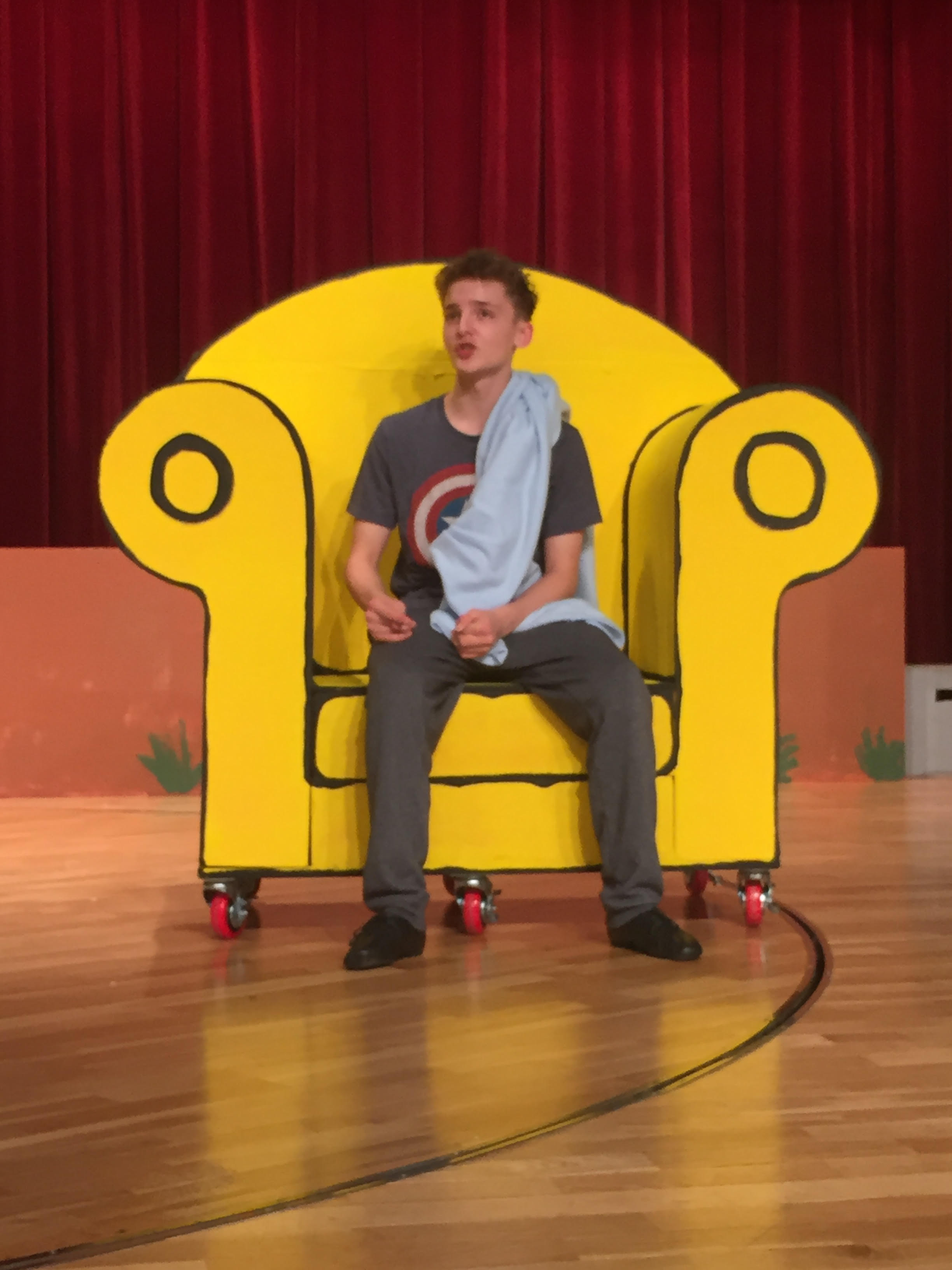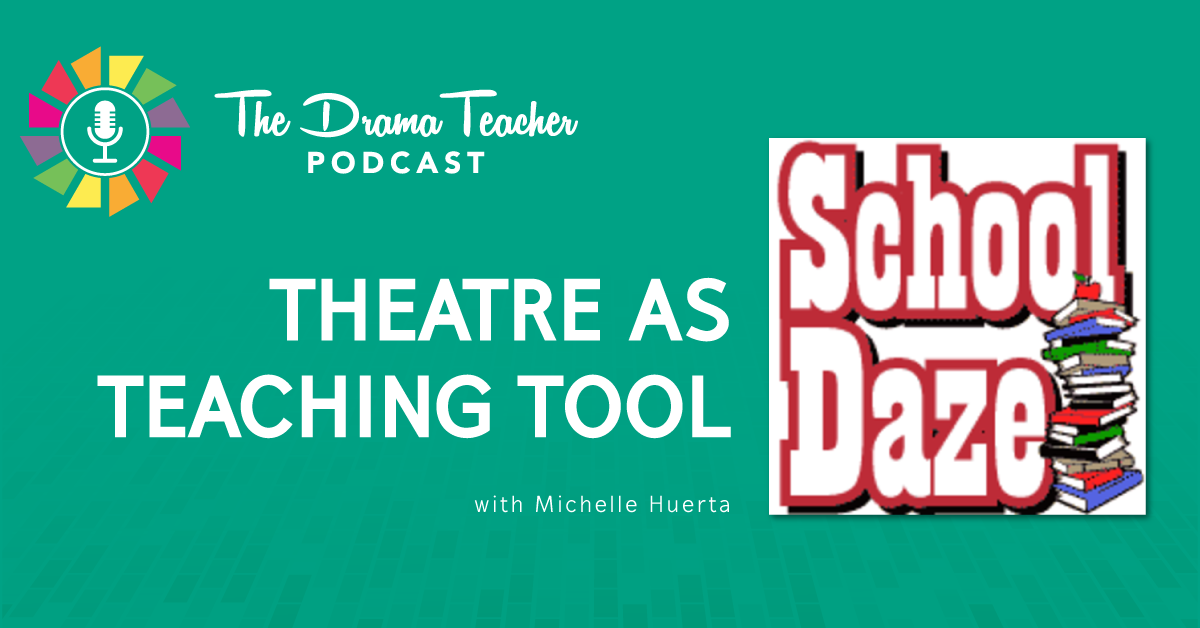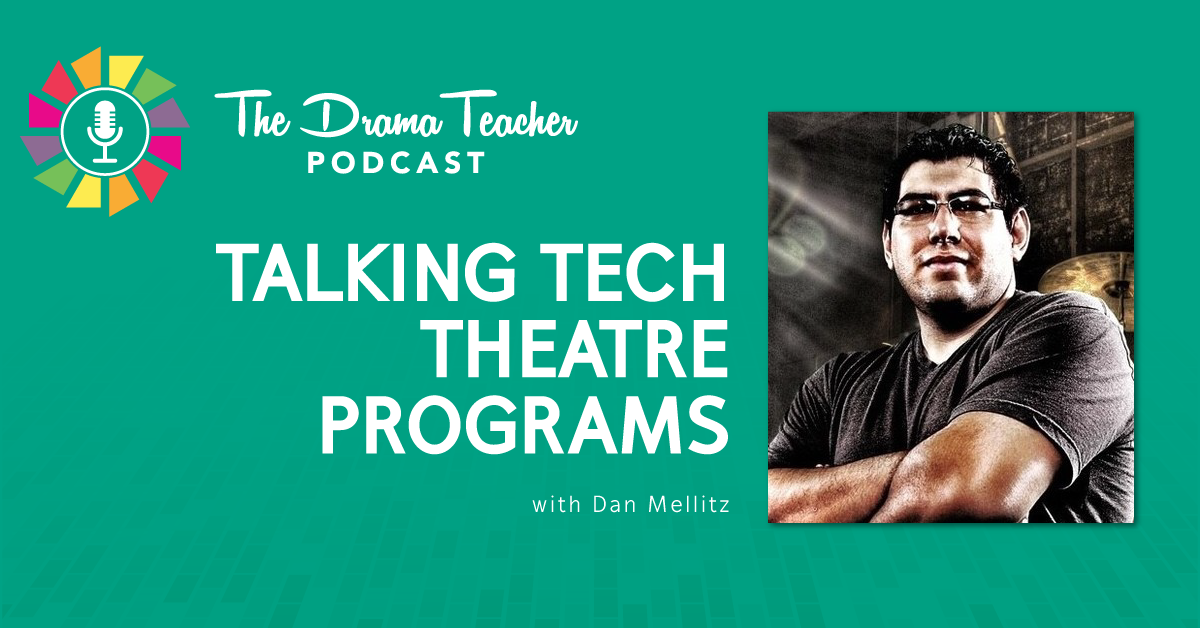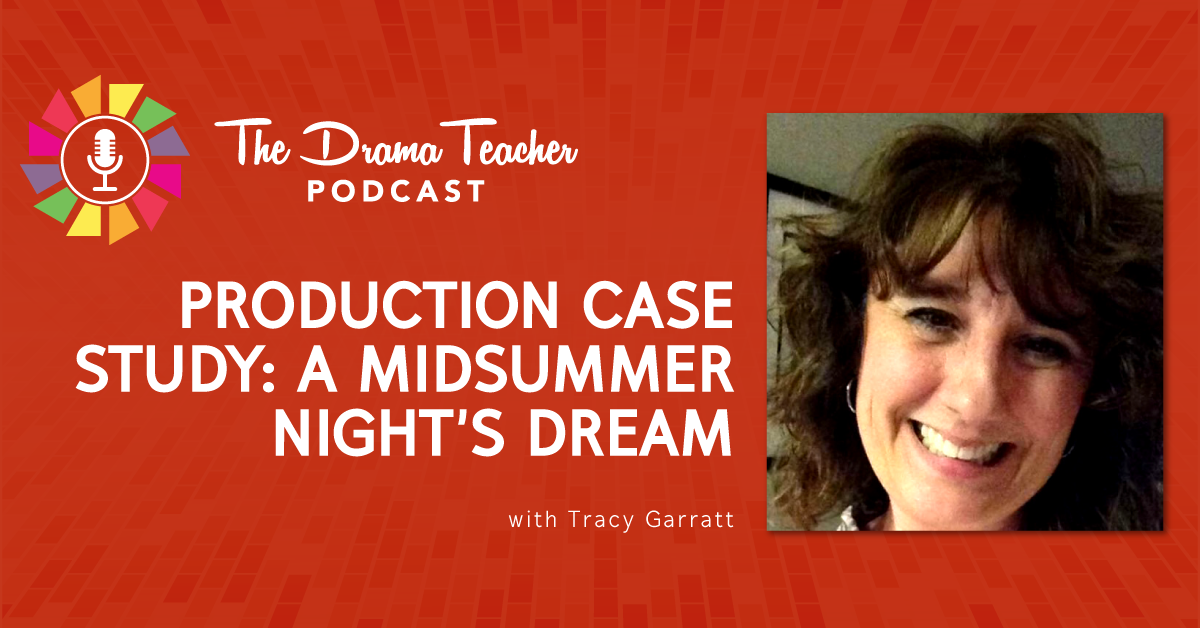Production Case Study: You’re a Good Man Charlie Brown
Episode 208: Production Case Study: You’re a Good Man Charlie Brown
Bekah Schneider is a teacher in South Korea and there was a lot to overcome with this production: students not knowing the source material, fear of failure, and doing choreography by Skype. After all that this was her best production experience in 20 years. Listen in to learn why!
Episode Transcript
Welcome to the Drama Teacher Podcast brought to you by Theatrefolk – the Drama Teacher Resource Company.
I’m Lindsay Price.
Hello! I hope you’re well.
Thanks for listening!
This is Episode 208, and you can find any links to this episode in the show notes which are at Theatrefolk.com/episode208.
Today, we’ve got a production case study. Oh, production case studies are some of my favorite, favorite episodes. I hope you like them, too! I hope you like them, but I like them because I love learning the how and the why behind a production, and this particular conversation is a real treat.
We’re talking musicals today – one particular musical – You’re a Good Man, Charlie Brown.
Our guest today had quite the experience with the show. Little teaser for you! Let’s find out why!
I’ll see you on the other side.
LINDSAY: Hello everybody! Welcome to the podcast!
I am talking with Bekah Schneider.
Hello, Bekah!
BEKAH: Hey there!
LINDSAY: First of all, tell everyone where in the world you are. You’re in an extra special place.
BEKAH: I am in Suwon, South Korea.
LINDSAY: This is pretty awesome because I’m doing this recording which will mean nothing to you much later in the time when this gets posted, but it’s a Thursday night, and where you are, it’s a Friday morning.
BEKAH: Yes, it’s true. It’s very fun.
LINDSAY: Yes, I’m sure it is. It must be hilarious when you’re trying to communicate home, you know?
BEKAH: Yes. Yes, exactly.
LINDSAY: How long have you been a drama teacher?
BEKAH: I have been a drama teacher officially in school systems, this is year seven.
LINDSAY: Were you an unofficial drama teacher?
BEKAH: Yeah. Actually, you know, I was a professional actress growing up and I did work in our state and traveled with our state. And then, I was a creative director at the church and did acting classes for students outside of that. I didn’t step into formal classroom education until much later in life, but it’s been very fun.
LINDSAY: What made you want to step into the classroom?
BEKAH: I loved what I did working with children, but I knew the influence of working with children would be greater if I had kind of a steady stream of students and classes. I am a single parent. And so, from a work perspective, teaching was something that I was passionate about already with the schedule and then working with children, and it just kind of all fit together. I get to do what I want to do which is drama. And so, I love it. I absolutely love it.
LINDSAY: How did you end up in Korea?
BEKAH: Ah! Now, that is a story!
My brother actually moved to Korea twenty years ago and has been in the international school scene. There’s quite a large community. In fact, even with our DTA community, there’s many of us from all over the world.
And so, he had been over here for twenty years and called me and said, “There’s a job and you should apply.” I said, “No, I’m super happy.” He’s my older brother, so he kind of bullied me and harassed me into at least looking at it.
And then, I applied confident that I would never get the job and confident that we would never move and, you know, we did. So, we’ve been overseas for three years now. It’s been really fun. We really felt like just the series of events that orchestrated us over here were pretty phenomenal and really unexpected. It wasn’t something we were looking for, but I’m so glad we’re here.
LINDSAY: What’s the makeup of the students that you teach? Is it international? Is it American? Is it Korean?
BEKAH: Yeah, this is an international school, but many of the Korean international schools will tell you that they are ethnically mostly Korean.
I would say we are probably – I think the last count was 80 percent Korean students, and those students hold passports from other countries. They have lived abroad in America or Canada. We have also Chinese and Japanese students and a strong Indian population. The company where I am is Samsung. And so, of course, as they bring in employees, their employees can then send their children to the international school.
I teach six through twelve. In our six through twelve school entirely, we’re at about 210 students. It’s a smaller school that way, but they’re really amazing, amazing students – just the kind you dream of working with truly.
LINDSAY: That’s so awesome! I was going to say, if they were mostly Korean, you must be dealing with English as a second language, but it kind of sounds like they’re well-traveled, so maybe that’s not an issue where you are.
BEKAH: They are more travelled, but actually we do have an issue with English as a second language. That’s something that, in every step of my classroom, oftentimes, when they come into the international school, this is the first time they’re forced to speak in English all the time. If they had lived abroad, they might have lived abroad younger – you know, early childhood years where, at home, they’re speaking in their mother tongue.
English is the expected language in every class and I’m amazed at how quickly they learn languages. I don’t have that gift. The students learn it. We struggle a lot with diction and enunciation and pronunciation. Words like “years” with a Y sound, they often will say “ears.” Instead of saying “years and years,” it’s “ears and ears.”
We have to work through some of those issues and how to move the mouth as an actor in this language. The Korean language is very closed-mouth when you speak. Of course, speaking in English – and with theatre – is a very mouth-moving language. And so, it’s been really interesting to see that with our students.
LINDSAY: Which leads us to a very interesting segue because what we’re actually going to talk about today is we’re doing a production case study. You, this fall, did You’re a Good Man, Charlie Brown.
BEKAH: Yes!
LINDSAY: Oh, there’s so many things to talk about in terms of just the singing of it and the choosing of it and the response of it. Let’s start with the choosing of it. Why did you choose this particular musical?
BEKAH: When I came to the school, when I started here, they had only ever done junior versions of musicals which I think have a place for sure and are great, but I had wanted to begin developing the students, working toward a full-length production.
And so, last year, we did a shorter musical. I knew this year we wanted to do a full-length musical. That was kind of step one. I didn’t want a junior. But, at the same time, I didn’t want my students to jump into 2.5 hours, you know, when they were at a 60-minute performance level.
And so, what’s a good transition piece?
The other challenge was the size of the cast. I felt like we had done a really big musical the year before – Snow White and the Prince – and that had 25 people in it plus cast and crew. It was huge for the school – for the size of the school. I have kind of committed to do a big show and a small show. Knowing that I needed to do a smaller show that wasn’t going to take them beyond what they could stretch to, I started looking at shows.
I am a theatre teacher and I do love listening to my Broadway soundtracks at home all the time. So, I can’t help it. I do it and Charlie Brown was one that I’d been playing for about two years. I don’t even remember why I came across the soundtrack. I have heard of other schools doing t before, but I have never seen it. And so, I don’t know why I ended up with this soundtrack, but I did, and I loved it and I shared it with our music director here and asked her what she thought – if we thought we could do it.
Our favorite thing that we’ve talked about with the show is that, when we listen to it, and we looked at it, we originally thought it was going to be so easy and wow! Those are words to live by! It didn’t end up being nearly as easy as we meant it to be for our students, but it was great.
The other thing for me in consideration with every show that I pick is what an audience will come to. While our community, the students, and staff speak English, many and most of the audience will not or they will have limited English. And so, trying to find stories that they might have seen or have connected to or have a frame of reference for, that was part of it.
And so, Charlie Brown, for a variety of reasons fit. You can go to the local 7-Eleven type stores here and see Snoopy-themed water bottles or juice boxes. You know, they kind of have a culture and Peanuts is over here and so it just kind of fit.
LINDSAY: I’ve got to say, that was one of my questions. Would they connect to the story?
The other thing I have to say is Book Report is my absolute favorite song of all time! I am not a singer but, if I was going to be in a show in a moment, I want to sing in Book Report. I just love it, and I’ve known the show. I actually have an original album which shows my age – a framed album in my bathroom. It will be in my bathroom.
Now, I was going to ask you about your vision, but I’m kind of getting the impression that, really, the vision for your show is growing your students and growing their ability to connect to full-length musicals with the down-the-road goal of a big one.
BEKAH: Yeah, exactly.
Next year, we are doing a big one. We just got our rights to our show for next year which is Shrek. That’s a big show, so we’re very excited.
My vision for the community – when I first got here, drama had not been done super well, and everybody hated it. So, step one was to get people to like drama. And then, step two was to get us to do it at a level that I know these students can do it. It’s been really fun to watch that, and we wanted to entertain, and I wanted to challenge the actors. I challenged them a little more than I anticipated, but it was very successful and super fun to see it.
LINDSAY: Okay! Let’s talk about the process.
First response of your students? What was the first response about the show?
BEKAH: The show title is You’re a Good Man, Charlie Brown. And so, the very first response when I put up audition notices for it which we auditioned in the spring of the previous year. We auditioned in May of last year.
The very first response is, “What is Charlie Brown? Who is Charlie Brown?”
And then, when I say Snoopy, then then go, “Oh! Does Snoopy sing?”
So, it was a little bit of a tough sell at first for them just because they know the characters. They didn’t think of it as a musical. Once I talked to different students and put out the soundtrack for them to listen to, then it was, “Oh, I can’t wait!”
They were very excited to get into it and do it. I found that – again, I didn’t anticipate this – there was a lot of fear for actors for even auditioning because they felt like this was so challenging to them and we hadn’t really even gotten into really the challenge of it – you know, full-length production and songs they didn’t know, and characters they didn’t know, and the Broadway soundtrack is amazing, and they were challenged and a little fearful to even begin with.
So, it was kind of a slow start for my group.
LINDSAY: How did you audition them?
BEKAH: You know, I’m a meanie. So, 16 bars and a monologue. They sign up for audition times. I have auditions every eight minutes. We use Google Forms for that. They come in. They sit with me and the music director and my tech director. They do it, and they leave, and I give them no feedback. And then, we put up the callback list, and then we bring callbacks in.
There are 16 bars. They can sing whatever they like, and we make them do that acapella. Our music director will take them through the piano to get their range when they first audition. And then, at callbacks, we put them into numbers. I think, “Oh, you might work for Charlie Brown. Oh, you might work for Sally. Let’s see how you would sound on that song.” And then, there’s some line-reading, cold reading with the size of the script, and then the cast list goes up the next day.
I do it in two days – you know, auditions and callbacks. And then, the cast list is up the next day.
LINDSAY: What was your pool like? Were you happy? Were you satisfied? Were you like, “I don’t see a Charlie Brown”?
BEKAH: Yeah!
You know, Snow White, we had 40 people audition, and it was amazing. And so, Charlie Brown, I anticipated a huge amount, and we had twelve.
LINDSAY: No!
BEKAH: It was horrifying because I didn’t know if we would have it who we would have. It was shocking. Again, that was that fear factor. So many students said they were too scared to audition which was shocking to me. I mean, the process was the same as last year’s process, but the show had scared them.
Of the twelve that auditioned, there are six in Charlie Brown if you just do the characters in the script which is what I wanted to do. Of the twelve, we wanted seven of them, and the issue became the seventh one. It was a girl, actually.
We had our guy parts pretty much right away. I have to say that, of the twelve who auditioned, there were a couple of students that I wish had auditioned. But, you know, as you pick a show, you don’t precast it, but you know your pool and you know who you’re thinking could play the part. And so, the people I had really hoped auditioned did audition. And so, that part made it easier.
We did have a Charlie Brown right away. The hardest part was Linus, Snoopy because we had an actor who was great at both, and then it became with our girls. Could we do a girl for Snoopy? And that’s what we decided to do.
We had Linus and Schroeder and Charlie Brown were guys, and then we had our three girls – one being Snoopy. Our extra girl, we made the decision to create the character of Woodstock for the show and have her sing along in the general chorus parts because her voice was great. Of course, seeing the show, Woodstock belongs in the show, I think.
Even though it’s not listed as a character, t should be. It’s a great part. And so, we made the part for the seven, crushed hopes and dreams for five who were young and happy to come back for the next audition. That was good.
But, yeah, it was a little intimidating seeing my sign-ups.
LINDSAY: What an experience for you to go from 40 to twelve. But, also, you know, maybe not this year, but maybe for Shrek they’ll come back because they saw maybe – hopefully – that there wasn’t so much to fear because others went through it.
BEKAH: Yeah, absolutely.
I think everybody who didn’t came up. It’s like that for a lot of shows, but they’ll come up and say, “You made me wish I auditioned!” and that’s the best thing that I can hear.
In Korea, culturally – and I’ve talked to the other drama teachers here – it’s not always but the fear of failure whereas, in America, my experience was kids would audition and tend to think higher of themselves and so you’d have 60 people – or everybody would audition – and there just wasn’t that fear factor. Here, to try for something is just a failure in their book, and they just cannot get past that. And so, if they didn’t think they could do it, they wouldn’t try out, and that has been wild.
And so, as we know we’re doing Shrek for next year, I’m already having lots of conversations, reminding students of how many places there are for people in Shrek and I think we will have massive auditions for Shrek now, but it’s culturally something that kind of surprised me. They don’t want to tell their parents or their friends, “I didn’t make it.” You don’t do that here, and it’s like that for sports. I mean, it’s across the board. They just don’t try if they can’t guarantee success.
LINDSAY: Wow! What an interesting barrier – an interesting roadblock for everybody. You know, when we think about what happens in the drama classroom, when failure is something we want to encourage because we want to encourage exploration, to have that extra step of “well, I’m not even going to audition because of the prospect of not getting a part.”
BEKAH: Yeah.
Yeah, it’s wild. You know, I’m so thankful that I get to teach classes. Some of my partners in crime out here in Korea, they’re more the director and they don’t necessarily have a lot of classes. I think that, if I didn’t have classes, I could at least have the conversations with students.
You know, some of my favorite things with auditions are the people who try out, and we did have one for the show who tried out who I had no idea. It’s my favorite thing when somebody that you don’t expect comes, right? And they discover something about themselves and you discover something new and the process of introducing somebody to theatre and helping them explore part of themselves. Our Lucy was that way.
She was a senior, and I was so thankful that she tried out and got to discover something, and she’s passionate about it, and it makes me sad for some of my students who I think miss out on parts of themselves. You know, they miss that exploration.
It’s kind of heartbreaking at times, especially with students that I know could do it, but hopefully I keep developing that in the classroom and we have more for Shrek. We certainly need more for Shrek.
LINDSAY: Well, that’s where it’s going to happen, eh? It’s going to happen in the classroom, and I think you’re really lucky that you have that intro – doorway, I guess – to sort of see if you can’t shift a few feet. That’s a lot of – not pressure, but that’s a great responsibility, I think, just to see what can happen.
You know what? It gives a little bit of weight to Shrek. It really does! What a great thing to work towards.
BEKAH: Yes!
LINDSAY: Okay.
How long did you rehearse?
BEKAH: We started auditions in May. We cast the show. We had two weeks of rehearsal in June, so we cast the last week of May, and we had our first rehearsal by read-through, scene-through, and for this show that was massive.
So, we did that in two weeks, and just kind of reviewed things. Then, the students took scripts home and were to memorize music. Ah! That rarely happens, but some do. But they were supposed to. Their assignment was to become familiar with Peanuts and to at least know the melodies of the songs.
Our music teacher is amazing, and she recorded all of their parts for them individually. And so, in the middle of July, those parts get posted for them, and they can begin singing through, so they had that home. But, when they came back, only one person really knew her music inside and out. And then, we rehearsed.
School starts here August 9th I think it was this year. It’s August 10th maybe next year. It’s early. So, we started in August and had rehearsals four days a week until the show in October and we had a ten-day holiday break literally the week before the show.
LINDSAY: Oh, my god!
BEKAH: Yeah, not my favorite. So, they rehearsed that way. They have two hours of rehearsal every day after school on the four days we’re allowed to have rehearsal.
Also, we used a choreographer from the US – one of my students. She Skypes in for choreography with us. And so, we have Saturday rehearsals because she does it Friday night for her and it’s Saturday morning for my students. So, there were three Saturday rehearsals they also had.
LINDSAY: All right, I’d just like to highlight this point. You did choreography through Skype?
BEKAH: Yes, love it!
LINDSAY: I think that’s amazing, so I’d like you to talk about that because lots of folks who will listen to this are like, “Oh, how do I get this? I don’t have anybody in my area.” Now, we do not advocate this for stage combat in no way, shape, or form. But choreography, how did that work?
BEKAH: Yeah! You know, it’s my second time doing it. She did Snow White for us, too.
The challenge for me is, out here, again, my community in the school, we speak English. But I live in Korea and communicating with a choreographer is not easy. I had a hard time even finding it. It’s just not something that’s done out here. You don’t hear much about dance. It’s kind of K-pop which is their Korean thing, so it’s very different. Last year, we didn’t have it.
So, I contacted my student who’s an amazing young woman. She’s a senior this year. When I go home in the summers, I see her and so I’d asked her about it and she said yes. I gave her all of the music and we talked through the script. I happened to be home in the summer and see her a lot. And so, we talked about ideas. But, really, she is a high school student. More happens over text message. So, we texted.
If I saw something that I kind of liked, you know, I would watch something or see something, I would say, “Hey! I want…” or give her ideas. I had not watched Charlie Brown at all. I’d never seen it and I was talking to her and I said, for the blankets, I really wanted the blankets to come alive. I said, “You know those dance sacks?” I’ve seen her dance recitals and I said, “Like that! I want that!”
And so, she sent me a video, actually. I don’t know if other schools have done that in our community, but there is a YouTube video of a Charlie Brown dance in the sack. And so, that’s kind of how the conversations would work. I would have an idea and I would say it to her and I don’t speak dance super well, right? I’m like, “I want a sack and I kind of want it to be really Broadway and some jazzy hands.” Maybe I’d find a clip of something.
LINDSAY: A couple of jazz hands! A couple of Broadway! Just go do something with that!
BEKAH: Go do something, right, yeah! That’s how she felt, right? But, I mean, I can tell if I like it or I don’t like it. I’m horrible that way.
She would find videos or take videos of herself and send it to me. I would say, “Yes, that’s what I want.” So, we had an idea going in. Then, when we Skype in with the cast, we set up a TV. The benefit of being here in Korea is the amazing technology that just, when I think back to my American school, you know, it’s night and day difference.
We have TVs that have computers on them with cameras. It’s a giant TV flat screen that they wheel into the auditorium, and then we hook our sound through our speakers and set her up so that she gets the widest angle of our stage. And then, she meets the students the first morning and they step forward.
I’ll have told her ahead of time, “You know, this student can really dance. That student, you know, jazz square might be a stretch.” And so, she gets that and then she will tell them what she wants to do and show them.
And so, she essentially acts like the teacher at the front of the classroom and walks them through step-by-step. We’ll stop and pause and do it again and stop and pause and do it again. Then, she’ll watch them, and I will do it along with them to get it.
At the end of the rehearsal, if anything has changed, she makes notes and sends me notes that say things in my terminology. Like, “You call this the chopsticks step, Bekah.” I’d say, “Okay, great!” So, we kind of use coded language for me that I know, but then the students practice it. And so, we Skype with her for about six hours, and she stays up really late, and we get to school really early, and we do as much as we can in that time. And then, we stay in the afternoon beyond that six hours. We stay for another four hours and practice that to get it locked in. and then, we’ll do that again to finish whatever choreography up.
I highly recommend it. I mean, the time difference is hard. But, if you don’t have choreography where you are, that has been a lifesaver for me and my students love it. We’re really excited. We’re traveling to Disneyworld in February to compete. She’s actually going to meet us there, so they can actually meet her in person.
You know, they’ve kind of created this amazing cross-continental friendship with a student who dances and is really gifted that way with students who are performers – acting and singing-wise. I just think it’s amazing. So, I highly recommend it.
LINDSAY: That is so amazing. Well, solve a problem, right?
BEKAH: Yeah.
LINDSAY: Awesome.
Okay. We’re going over for our time here.
BEKAH: Sorry!
LINDSAY: Oh, no, you’re great! You are great! This is awesome!
I don’t want to take too much more of your time.
As you’re getting to the end of rehearsal, was there ever a moment of “this is not going to work”?
BEKAH: You know, with this show, no, there really wasn’t.
Now, that is unusual. Let me just say that ahead of time. But the actors that came in for this show – the seven that we had – I think it is unlikely that I will ever have this kind of experience with a group again. It was a magical experience. Their dedication and effort was unsurpassed.
I’m in production. You know, we’re two weeks from our next production right now, and I have that right now for my current one where I’m like, “Uh, I don’t know… I don’t know.” But, this one, the actors were amazing.
The scariest thing for us was our Charlie Brown had tonsil issues and we were concerned that he would lose his voice. And so, we had some voice issues that we had to really just watch in rehearsals. But, no, these kids, I think they could have performed it two weeks earlier. It was unreal.
I hope every director has that experience once that’s just so magical that you’re refreshed as a human being and as a creative person. It was phenomenal.
LINDSAY: When was the point – and there must have been because, obviously, this group jelled together. When was the point where you could see in their eyes that they could do it and that that fear was gone?
BEKAH: When we sent them home with the music for summer, they were traumatized. When they came back from summer, they were still traumatized, but they worked.
The first two weeks were just music rehearsals with our music director. There’s this song, Happiness. My music director would say, arguably, it’s the easiest song in the show, but it is a beautiful song with some lovely acapella in it and gorgeous harmony. So, she had worked that song.
During those two weeks, I was working set design and just in and out because it’s the music rehearsal and it’s not so much me at that point. So, I had not been in that rehearsal and came in for the end of it. She said, “Hey, do you want to hear it?” and I said, “Yeah, let’s do Happiness.”
They stood up, and I recorded them, and they sang it. I was so blown away by where they were at and they could hear it. I played that video back for them, so they could hear it, too. I think that was the moment that they realized it didn’t matter what they worried about. They could do it, and they sounded great doing it. I mean, it’s just a marker in their show.
From that point on, they didn’t say, “I can’t” or “It’s hard.” They said, “We’ll get it!” Literally, that was the vocabulary. “We’ll get it!” and they did. It was just amazing.
LINDSAY: That’s awesome! There’s nothing like that, is there? When you can’t tell them that, it changed for them.
BEKAH: Yeah.
LINDSAY: I’m so glad you brought up doing the set because I did want to talk about that, too. What was your vision for set and costumes? How did you stage this?
BEKAH: Yeah, our school has got a lovely stage with no fly space – zero fly space. So, we have offstage. In looking at it, I thought it was going to be a challenge, but what I really wanted to do, I just had seen our school does an arts night where the art kind of stuff comes up, and one of the students had done some pop art and I saw it and I thought, “Oh! I think pop art and Charlie Brown make sense!”
I wanted to stay very true to a comic book feel or the comic strip feel. I didn’t want any realism. You know, no part of it did I want to feel any way natural or real. I wanted it very cartoony. So, we went with pop art. I have a set designer who is a student and I told him that I wanted pop art and comic strip.
And then, I have a set – the graphic designer one – and we had talked about the idea of doing banners in Korea – and probably in the US, too – but I didn’t use banners until I got to Korea. Korea uses banners like you would hang out in front of the school to advertise something. They use them for everything. The idea was, “How about we use banners for our backdrop since we don’t have fly space?”
The graphic designer created comic strip panels for the sides with the character faces. We got permission from Tams-Witmark to do that because you have to have permission to use the likenesses for the show, and that was just on the stage. Their character faces looked like giant comic strips down the side, and we went with very bright, vivid colors, and everything was oversized.
We use Styrofoam. If you don’t use Styrofoam, you should use Styrofoam. Styrofoam is the best!
We actually built our boxes out of Styrofoam and the chair – the big oversized chair for the show – was entirely built out of Styrofoam and then we just put casters on it.
We had a wall across the back that the students used and then created these 3D pop art clouds. The whole time, you just felt like you were looking at a comic and I think it’s the set I’m the most proud of as a director. I had the least to do with it which is probably why I’m the most proud of it and why it turned out the best.
When you can give over that creative ability to other people who can really execute it well, it was really fun to see it, and they had a lot of fun doing this one. You know, we do realism so much in theatre that it was fun to just go crazy, but it was a really simple set.
Beyond that, we had the doghouse, the chair, the wall, and the boxes that the actors stood on, and that was it besides the banners. But it was amazing, I think.
LINDSAY: It sounds really visual. You know, you don’t need a big set.
BEKAH: You don’t.
LINDSAY: Which is another thing that is a good thing to just sort of put out there.
BEKAH: You don’t need a big set.
We’ve had audience reviews. The Korean International School community, the drama teachers who go see each other’s shows with our students and they write reviews – sort of like cappies in the US. The set was the thing that was the most talked about because it was so simple. Everybody said, “It was so simple what you did, but it was brilliant.”
And so, I encourage people to trust simple because it really does work.
LINDSAY: I think that’s a lovely place to end.
Trust simple, especially when we’re talking about musicals because people get it in their heads – you know, we have to copy what has come before, and that’s not feasible for anybody.
BEKAH: Yeah, absolutely.
LINDSAY: Bekah, this has been awesome. I’ve really, really enjoyed hearing your experience with the show and how you took a risk and it seems like it paid off for you, eh?
BEKAH: Yeah, it did. It’s the best experience I’ve probably had with theatre in twenty years, and I love theatre! So, it’s not that I’ve had bad experiences. It’s just – wow – it was amazing.
LINDSAY: Awesome. Thank you so much!
BEKAH: Thank you!
LINDSAY: Thank you, Bekah!
Before we go, let’s do some THEATREFOLK NEWS.
So, Bekah mentioned the DTA in our conversation – that’s the Drama Teacher Academy, the education arm of Theatrefolk just for drama teachers. There’s professional development courses. Did you need clock hours to renew your certification? Curriculum including a full Drama I and Drama II curriculum. Plus, many emergency lesson plans, resources, and the best part of DTA – its community.
You can participate in monthly professional learning community events with drama teachers from all over the world. Bekah has been a panelist many times from Korea. In our private Facebook group, you will never meet a more dedicated, more ready-to-help group of people than our DTA members. Got a question or a struggle? They’ve got an answer. You just want to celebrate something? You are not alone.
Find out more at DramaTeacherAcademy.com – that’s all one word. Or click the link in the show notes – Theatrefolk.com/Episode208.
Finally, where can you find this podcast? Go to Theatrefolk.com/podcast and there you will see we are on iTunes, Android, Google Play, Stitcher, and more. That’s Theatrefolk.com/podcast.
And that’s where we’re going to end.
Take care, my friends. Take care.
Music credit:”Ave” by Alex (feat. Morusque) is licensed under a Creative Commons license.
